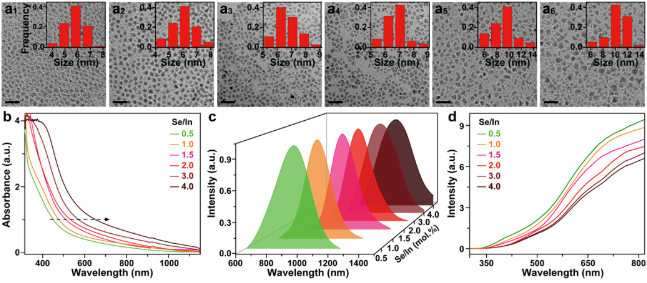
hotline:
17715390137
Tel/Wechat:
18101240246 (Technology)
0512-68565571
Email:mxenes@163.com (Sales Engineer)bkxc.bonnie@gmail.com
Scan the code to follow or search the official account on WeChat:
2D Materials Fronrier After paying attention,
click on the lower right corner to contact us,
Enter enterprise WeChat.
Professional Services Online

Recently, the team of researcher Chen Xueyuan from the Fujian Institute of the Structure of Matter of the Chinese Academy of Sciences has made new progress in the near-infrared two-zone luminescent quantum dot biomarker. The team successfully developed a broadband excitable CuInSe2 (CISe)-based new high-efficiency near-infrared two-zone luminescent quantum dot bioprobe, and applied it for the first time in circulating tumor cell (CTC) detection and tumor targeted real-time imaging (Figure 1) .
Candidate recommendation of "2020 China Optics Top Ten Progress"

Figure 1. Schematic diagram of blood circulating tumor cell detection and tumor targeting real-time imaging based on CISe@ZnS new near-infrared two-zone quantum dot bioprobe.
Near-infrared two-zone luminescence (950-1700 nm) has low scattering in living organisms, deep tissue penetration and high imaging resolution. It has very important application prospects in analytical chemistry and biomedicine. In particular, the near-infrared two-zone inorganic quantum dots have received extensive attention from domestic and foreign scholars due to their characteristics such as adjustable emission wavelength, large absorption cross-section and high quantum yield.
At present, the main research on near-infrared two-zone quantum dots is II-VI and IV-VI semiconductor materials, such as CdSe, CdTe and PbSe, etc. The heavy metal elements contained in them (such as Cd2+ and Pb2+, etc.) greatly limit their subsequent Biomedical applications. Therefore, the development of near-infrared two-region quantum dots with good biocompatibility and high-efficiency luminescence is the current research hotspot and difficulty in the field of biomarkers.
The team selected CISe, which does not contain heavy metal elements and has a small band gap, as the research object. By accurately designing the Se/In composition ratio in the material, the emission peak position of CISe is adjusted from 920 nm to 1224 nm in the second region of near infrared; the excitation spectrum of the synthesized quantum dots can cover ultraviolet to near infrared (350-820 nm) ), which can be applied to excitation light sources of multiple wavelengths in practical applications (Figure 2). After the ZnS shell is coated, the stability of CISe can be significantly improved, and its absolute quantum yield of near-infrared second-region luminescence under 808 nm excitation is as high as 21.8%, which is the highest value of non-toxic near-infrared second-region quantum dots reported so far .

Figure 2. (a) TEM bright-field image and particle size statistics of CISe quantum dots synthesized with Se/In molar ratios of 0.5, 1.0, 1.5, 2.0, 3.0, 4.0; the synthesized series of CISe quantum dots (B) Absorption spectrum, (c) Emission spectrum and (d) Excitation spectrum.
Furthermore, by connecting the anti-epidermal cell adhesion molecule (EpCAM) antibody, the team can use CISe@ZnS probe to realize the specific recognition of CTC (such as human breast cancer MCF-7 cells) and the detection of CTC in blood samples The limit can be as low as 12 cells/96 wells (200 μL). In addition, the team also applied the CISe@ZnS-based near-infrared two-zone luminescent probe to tumor-targeted real-time imaging in living mice. The main organs and blood vessels are clearly visible. The blood vessel resolution is as low as 0.36 mm and the signal-to-noise ratio is as high as 5.8. (image 3). It is worth noting that the probe can be excreted from the body through the renal channel and liver channel 4 hours after the tail vein injection, showing the advantages of good biocompatibility and easy metabolism. This work provides a new idea for the development of high-efficiency and non-toxic near-infrared two-zone luminescence biological probes.

Figure 3. Live mouse (a) back and (b) bright field images of the abdomen, and near-infrared two-zone imaging after intravenous injection of the CISe@ZnS probe; (c) changes in the luminous intensity of different parts after the probe is injected; (D) The resolution of blood vessel imaging; (e) The luminous intensity changes of tumor and non-tumor parts after probe injection.
Related research work was published on "Nano Today" on August 21, 2020 with the title "Broadband excitable NIR-II luminescent nano-bioprobes based on CuInSe2 quantum dots for the detection of circulating tumor cells". This result was completed by the team of researcher Chen Xueyuan from the Fujian Institute of the Structure of Matter, Chinese Academy of Sciences. Lian Wei is the first author of the paper, and associate researcher Tu Datao and researcher Chen Xueyuan are the corresponding authors.
This work was supported by the Strategic Leading Science and Technology Project of the Chinese Academy of Sciences, the National Key R&D Project of the Ministry of Science and Technology, and the National Natural Science Foundation of China.
Paper link:
https://doi.org/10.1016/j.nantod.2020.100943
Article source: Ai Guang
This information comes from the Internet for academic exchange only. If there is any infringement, please contact us to delete it immediately.

| Reminder: Beijing Beike New Material Technology Co., Ltd. supplies products only for scientific research, not for humans |
| All rights reserved © 2019 beijing beike new material Technology Co., Ltd 京ICP备16054715-2号 |